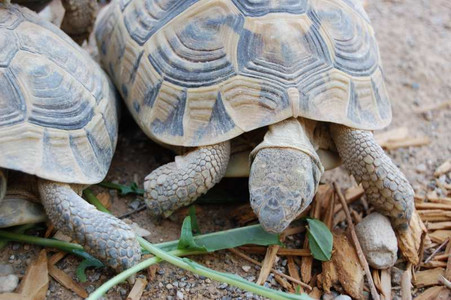- Home
- Tortoises For Sale
- Hermanns Tortoises For Sale
- Hermanns Tortoise (Eastern) 4"+ Young Adults
- Home
- Tortoises For Sale
- Pet Tortoises For Sale - 4" Size or Larger
- Hermanns Tortoise (Eastern) 4"+ Young Adults
Hermanns Tortoise (Eastern) 4"+ Young Adults
Product Reviews
Description
Common Name: Eastern Hermanns Tortoise
Scientific Name: Testudo Hermanii Boettgeri
Current Size: 4-5" range
Average Adult Size: 6-9" (females larger)
Area of Origin: Greece, Macedonia, Bulgaria and Albania
Description: Light brown color with brown to black bands around each scute of the shell. These pretty tortoises are very similar in look to some localities of Greek tortoises, but lack the spurs on the rear thighs that Greeks have, as well as different colorations on the belly.
Habitat: Mediterranean tortoises, these animals live in grassy meadows and scrubland where they come and go from their burrows in order to maintain the ideal temperatures. They do hibernate naturally, and will hibernate in captivity if proper conditions are given. Our hermanns are some of the earliest Testudo to go down in the fall, and last to rise in the spring. As adults, they can safely handle body temperatures as low as 35 degrees during hibernation, and on cold spring, summer or fall months, they will retreat underground to maintain some warmth. Summer highs up to 110 degrees can be tolerated as long as there is a cooler, underground retreat the tortoise can get into. In hot climates, they will spend much of the summer days in burrows or simply buried under an inch or two of earth.
Diet: This tortoise is naturally a browser, eating broadleaf weeds and low leaves from bushes and shrubs. In captivity, Hermanns tortoises will graze on leafy weeds, dandelion, clover, and most other leafy greens provided to them. As babies, we focus more on feeding them a wide mix of leafy greens (spring mix). Vegetables can be added to the diet for variety, but fruit should generally be avoided or given as no more than 5-10% of the diet.
Adult Behavior: Adult hermanns tortoises are active, busy tortoises when the temperatures are in their ideal ranges (60-85 degrees). They are un-aggressive towards each other in most cases, and can be kept in small groups. The mating habits can create some problems as males will occasionally bite at the females to subdue them, and sometimes will ram at each other to establish dominance through the ranks. Most will eagerly come to their keepers looking for food once they are comfortable in their environments. They are good climbers and will make attempts to escape, so perimeter fences should be buried at least 6-12" underground, and sidewalls 12-16" above ground will normally contain them.
 Loading... Please wait...
Loading... Please wait...

